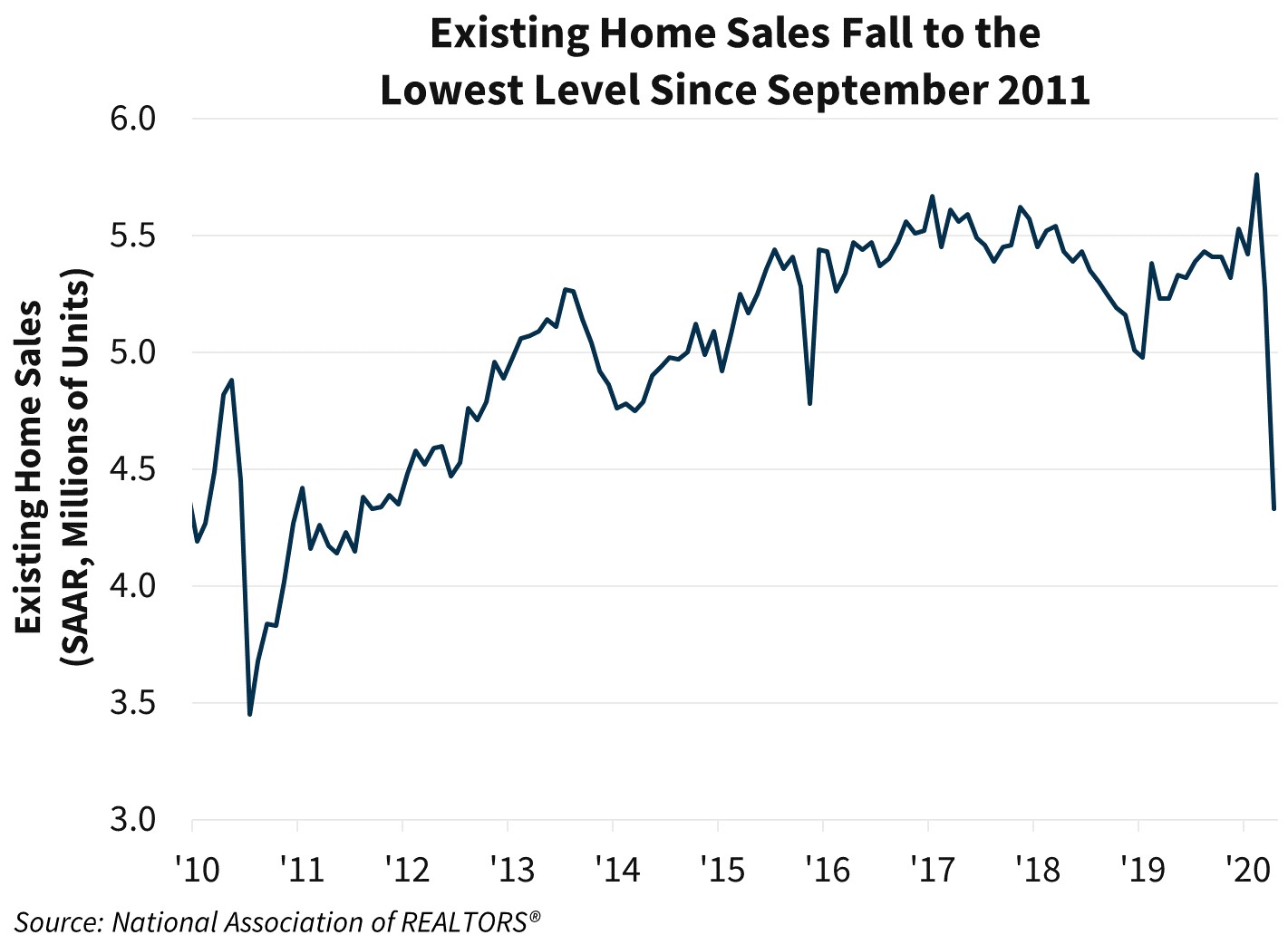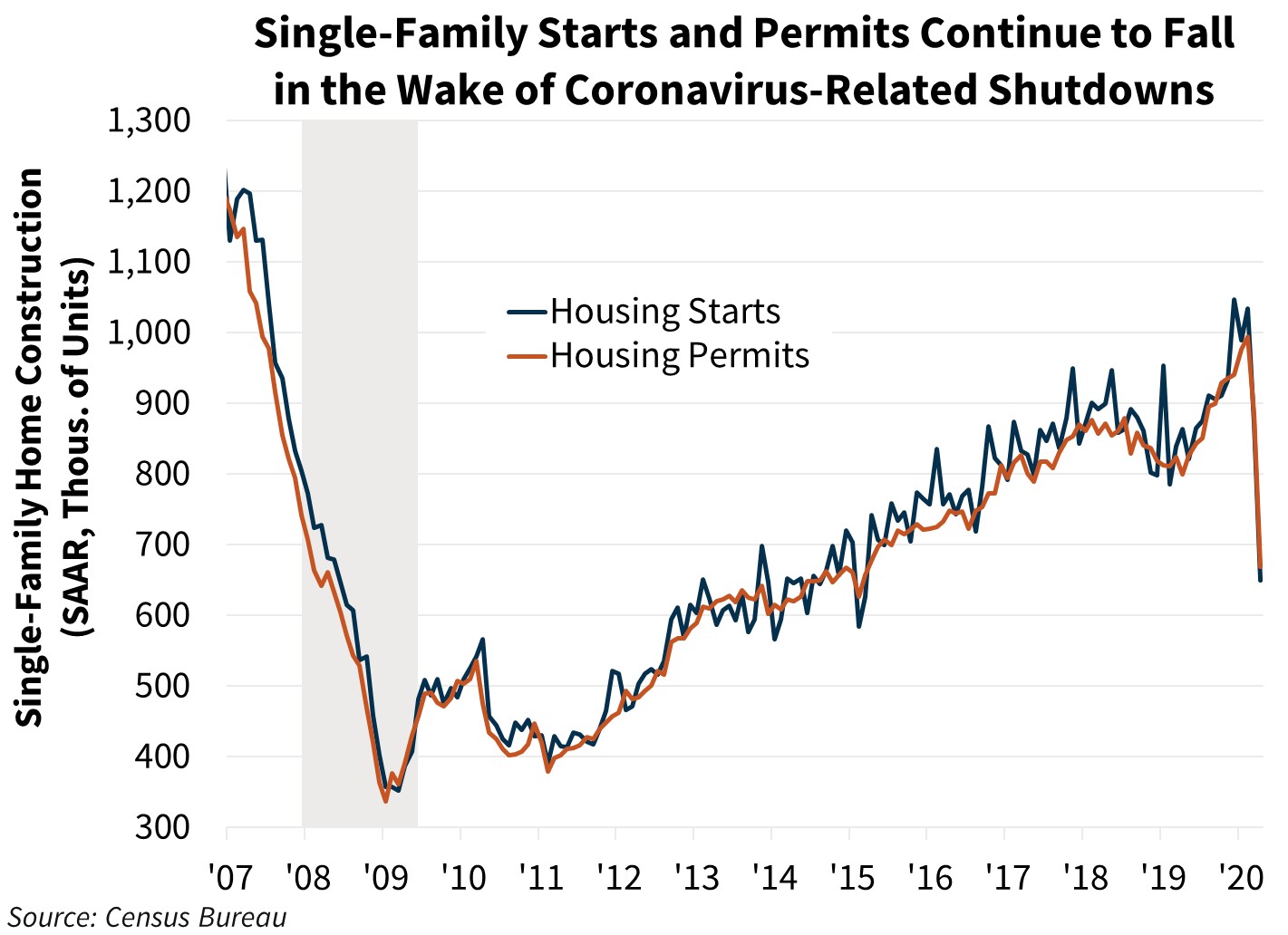Housing Activity Falls Sharply in April, Though There Are Signs of a Rebound
Key Takeaways:
- The Federal Open Market Committee (FOMC) released the minutes for its meeting on April 28-29, where the FOMC decided to keep the target range of the federal funds rate between 0.0 and 0.25 percent. Meeting participants noted that second quarter economic activity would likely decline at an ”unprecedented rate” and that “the ongoing public health crisis would continue to weigh heavily on economic activity, employment, and inflation in the near term and would pose considerable risks to the economic outlook over the medium term.”
- The Conference Board Leading Economic Index (LEI), a gauge of the economic outlook over the next three to six months, fell 4.4 percent in April and 11.3 percent in the six-month period ending in April. The only positive contributors were stock prices, interest rate spreads, and new orders for consumer goods/materials and core capital goods.
- Existing home sales dropped 17.8 percent in April to a seasonally adjusted annualized rate (SAAR) of 4.33 million, according to the National Association of REALTORS®. This is the lowest level of sales since September 2011, as well as the largest monthly decline since July 2010. Single-family sales fell 16.9 percent to a SAAR of 3.94 million, the lowest level since the end of 2011, and condo/co-op sales decreased as well. The months’ supply for total existing homes jumped seven-tenths to 4.1 (non-seasonally adjusted).
- Housing starts fell 30.2 percent in April to 891,000 annualized units, the lowest level in five years and the largest monthly decline in the 61-year history of the series. Single-family starts declined 25.4 percent to 650,000, while single-family permits dropped 24.3 percent to 669,000, the lowest level in five years.
- The National Association of Home Builders/Wells Fargo Housing Market Index (HMI) increased by 7 points in May to 37. While this was the largest increase in almost seven years, it followed April’s 42-point decline, the largest decrease in the series’ history. The present single-family sales component increased, as did the index for single-family sales over the next six months, which posted the largest increase in almost eight years.
- Mortgage applications fell 2.6 percent for the week ending May 15, according to the Mortgage Bankers Association. The decline was driven entirely by refinance applications, which fell 6.3 percent to the lowest level since the end of February. Purchase applications rose 6.4 percent, the fifth consecutive week of increases, to the highest level in two months.
Forecast Impact
Economic data continued to deteriorate in April, supporting our current forecast of a decline in GDP growth of almost 40 percent annualized. The LEI also seemed to indicate a significant contraction, though supportive monetary and fiscal policies appear to be keeping some aspects of the economy afloat. Despite the weak incoming data, there are glimmers of a rebound in coming months. New orders of core capital goods and consumer goods were positive contributors to the LEI, potentially signaling an increase in orders in anticipation of states beginning to reopen. April’s existing sales reflect contract signings that occurred in March or even February, before the majority of COVID-19-related social distancing measures went into effect, suggesting sales are likely to fall further in May. However, mortgage applications and other high frequency data show that homebuying interest has posted a surprisingly quick recovery in recent weeks, suggesting a near term trough in sales and perhaps a solid recovery beginning in June. If this trend is sustained, we would likely have to increase our expectations for home sales in the coming quarters. There is a similar dynamic in new home construction, as well. While housing starts dropped significantly in April, the May NAHB HMI also points to a rebound in homebuilding activity. As more states begin to reopen and loosen current restrictions, combined with low mortgage rates, we believe construction should begin to stage a recovery, especially if the current level of homebuying interest is sustained through the coming months.


Details on Key Takeaways and Other Releases
- The Conference Board LEI fell 4.4 percent in April to 98.8. The three largest negative contributors were average weekly manufacturing hours, initial unemployment claims, and building permits. The press release stated that, while conditions may recover for some sectors over the coming months, “the breadth and depth of the decline in the LEI suggests that an imminent re-opening of some sectors does not imply a fast rebound for the economy at large.”
- Existing home sales dropped 17.8 percent in April to a SAAR of 4.33 million, according to the National Association of REALTORS®. Our May forecast shows a sales pace in the second quarter of around 3.88 million, though our forecast is a quarterly average, and monthly data is often revised. First-time homebuyers represented 36 percent of sales in April, up from 32 percent a year ago. Individual investors or second home buyers accounted for 10 percent of sales, down from 16 percent a year ago. Condo/co-op sales declined 26.4 percent to a SAAR of 390,000, the largest decline since the series began in 1999. Existing homes available for sale saw a steep decline, falling 19.7 percent from a year ago to a SAAR of 1.47 million, the lowest April reading in the history of the series. The median sales price, which is not adjusted for the mix of sales, rose 7.4 percent year over year.
- Housing starts fell 30.2 percent in April to a SAAR of 891,000, according to the Census Bureau. Currently, we expect housing starts in the second quarter to fall to a SAAR of 957,00, though our forecast is a quarterly average, and monthly data is often revised. The declines were across every region. Multifamily starts dropped 40.5 percent, the largest drop in 28 years, to a SAAR of 241,000. Multifamily permits fell 14.2 percent to a SAAR of 405,000, the lowest level in four years.
- The National Association of Home Builders/Wells Fargo HMI increased by 7 points in May to 37. The Northeast was the only regional index to decline. The present single-family sales component increased six points to 42, while the index for single-family sales over the next six months jumped ten points to 46. The index for the traffic of prospective buyers also rose, increasing 8 points to 21, the largest increase since the end of 2017.
Economic and Strategic Research Group
May 21, 2020
Opinions, analyses, estimates, forecasts and other views of Fannie Mae's Economic and Strategic Research (ESR) Group included in these materials should not be construed as indicating Fannie Mae's business prospects or expected results, are based on a number of assumptions, and are subject to change without notice. How this information affects Fannie Mae will depend on many factors. Although the ESR group bases its opinions, analyses, estimates, forecasts and other views on information it considers reliable, it does not guarantee that the information provided in these materials is accurate, current or suitable for any particular purpose. Changes in the assumptions or the information underlying these views, including assumptions about the duration and magnitude of shutdowns and social distancing, could produce materially different results. The analyses, opinions, estimates, forecasts and other views published by the ESR group represent the views of that group as of the date indicated and do not necessarily represent the views of Fannie Mae or its management.
